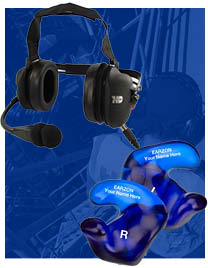The Critical Role of Hearing Protection in the Mining, Oil, & Gas Industries
Protecting your workers' hearing is more than just a compliance measure or a strategic investment.

Many people experience daily prolonged exposure to high noise levels while on the job. This is especially prevalent in the mining, oil, and gas industries, where heavy machinery and high-powered equipment operate around the clock. This noise poses a serious threat to the auditory health of workers. In fact, according to the CDC, approximately 23% of all mining, oil, and gas (MOG) workers have hearing difficulty.
In this blog post, we’ll explore the importance of hearing protection in the MOG sector, examining:
- damaging levels of noise
- the significance of headsets and molded earpieces
- regulations established by OSHA to ensure the safety and well-being of industry professionals
Understanding damaging noise levels
We all know that mines and drilling sites can get pretty loud. From the rumble of drilling equipment to roaring engines of heavy machinery, noise levels can easily exceed 70 decibels (dB), which can result in irreversible hearing damage after prolonged exposure. This noise can even climb above 120dB, which can cause immediate damage to your ears. Without proper protection, workers risk hearing loss and other related health issues. Learn more about what sounds can cause hearing loss here.
The importance of molded earpieces and headsets
For MOG workers, hearing protection must go beyond conventional earplugs. Specialized headsets and molded earpieces play a pivotal role in mitigating the impact of high noise levels. These devices are designed to provide a snug fit, effectively sealing the ear canal and blocking noise. Unlike generic earplugs, which may not fit every ear shape or offer substantial noise reduction, molded earpieces are unique to each user, ensuring optimal protection. 
Headsets, equipped with noise-canceling technology, add an extra layer of defense by actively reducing ambient noise. Most have certified noise reduction ratings, so you know exactly how much protection they offer. There are even different styles of headsets to maximize the overall comfort of workers who must wear them most of their workday.
Headsets offer more than ear protection; they also work as an extension of your two-way radio so users can easily hear and transmit messages hands-free. This ability to relay clear instructions and warnings is critical to ensuring safety and operational efficiency.
OSHA regulations for noise exposure
To address the risks associated with noise exposure, the Occupational Safety and Health Administration (OSHA) has established regulations to safeguard workers. The permissible exposure limit (PEL) for noise is 85dB averaged over an 8-hour workday. When noise levels exceed this limit, employers are required to implement hearing conservation programs. These programs include providing hearing protection devices, regular audiometric testing, and employee training.
More than just a requirement
Beyond the regulatory requirements, there’s a strong case for MOG employers to invest in quality hearing protection for their teams. A workforce equipped with effective hearing protection translates to increased productivity and fewer on-the-job accidents. Clear communication, facilitated by advanced headsets, enhances coordination and efficiency. Prioritizing the well-being of employees underscores the value of each team member and nurtures a culture centered around safety and respect.
Bottom line: providing robust hearing protection for mining, oil, and gas workers is more than just a compliance measure or a strategic investment; it’s the right thing to do.
Contact Air Comm today to find the right hearing protection solution for you!
